2012 Volume Issue 28
December 31, 2012
For a downloadable version, click the following:
…a bit more compressed version of the PDF
Rising Government Expenditures, Rising Tax Rates, and Sovereign Risk…a recipe for disaster – part two
One week ago, we published a newsletter on this website about taxes levied by the government. We discussed such things as the impending fiscal cliff, sovereign risk, and the ongoing in unacceptably high unemployment rate.
THE FISCAL CLIFF… Those that ignore the lessons of history will have to relive them…part one - revenues
www.econnewsletterdec242012.com/
That newsletter was preceded by another discussing the monthly labor report by the U.S. Department of Labor. It was very dismal. While it showed both the U-3 and U-6 measures of the unemployment rate falling, it was all smoke and mirrors.
NOVEMBER 2012 MARKS ANOTHER HORRIBLE MONTH FOR THE EMPLOYMENT SITUATION IN THE U.S.
www.econnewsletterdec132012.com/
What happened was a continuance of the persistent decrease in the labor force participation rate. Had that not happened the unemployment rate would not have fallen, in fact it would have risen. We pointed out that the experience of U.S. history over the past century shows us that tax rate increases do not stimulate the economy, rather they depress it.
On the other hand, going back to the Harding and Coolidge era in the 1920s, inspired by the Secretary the Treasury Mellon, Congress reduced the tax rates significantly and sparked a relatively long period of prosperity often referred to as the Roaring Twenties.
After the Great Depression and the Second World War, in spite of President Truman’s urgings (he wanted to put in place more of FDR’s New Deal policies), Congress once again lowered tax rates that had reached historical highs under the leadership of Roosevelt (FDR). The civilian economy had been depressed from the beginning of the 1930s and finally began to experience its first substantial and sustained positive rate of economic growth in a peacetime economy since 1929.
It wasn’t until the Revenue Act of 1945 was passed (cutting tax rates) by a Democratic Congress that prosperity finally returned.
Did FDR End the Depression?
Roosevelt died before the war ended and before he could implement his New Deal revival. His successor, Harry Truman, in a 16,000 word message on Sept. 6, 1945, urged Congress to enact FDR's ideas as the best way to achieve full employment after the war.
Congress—both chambers with Democratic majorities—responded by just saying "no." No to the whole New Deal revival: no federal program for health care, no full-employment act, only limited federal housing, and no increase in minimum wage or Social Security benefits.
Instead, Congress reduced taxes. Income tax rates were cut across the board. FDR's top marginal rate, 94% on all income over $200,000, was cut to 86.45%. The lowest rate was cut to 19% from 23%, and with a change in the amount of income exempt from taxation an estimated 12 million Americans were eliminated from the tax rolls entirely.
Corporate tax rates were trimmed and FDR's "excess profits" tax was repealed, which meant that top marginal corporate tax rates effectively went to 38% from 90% after 1945.
Even though tax rates remained low early in the Post WWII years after the just referred to tax rate cuts, tax revenues continued to grow and outpaced government spending with the resulting effect being that of experiencing a slowing growth rate of the economy and triggering fears of economic stagnation. This was a concern of both Presidents Eisenhower and Kennedy, culminating in Kennedy (JFK) convincing Congress to once again, lower the tax rates, eliminating the fear of economic stagnation.
George Bush II began his first term facing an extremely weak economy that had collapsed in the last year of the second term of President Clinton. President Bush convinced Congress that reduced tax rates were needed and as the so-called Bush tax rate cuts became effective, economic growth recovered from the sharp downturn at the end of 2000 which continued into 2001.
Historical data shows, that despite the financial crisis of 2008 and a temporary drop in tax revenues, tax revenues began to rise again and have continued to rise throughout the past three years under President Obama.
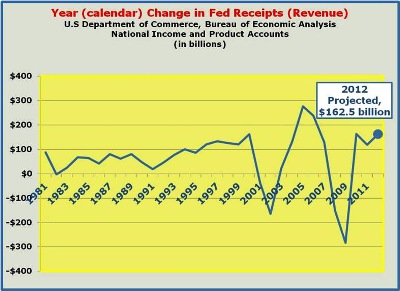
The enormous ballooning of the federal government’s budgetary deficit has been due to an explosion in government spending for the past four years that has far outstripped even rising tax revenues. This precipitous climb in Federal Government spending, contrasts sharply with the disciplined control of such spending throughout most of the previous Post WWII period.
It is to the dramatic rise in government expenditures and the effects of those increases to which we now turn.
We had mentioned in an earlier newsletter on this website, that the sharp increase over the last four years in federal government spending that has resulted in a dramatic increase in the federal budgetary deficit to the tune of nearly $1 trillion per year despite the fact that with the exception of beginning of the financial crisis, tax revenues have been rising steadily. The Monthly Treasury Statements from the U.S. Treasury Department attest to this ongoing crisis.
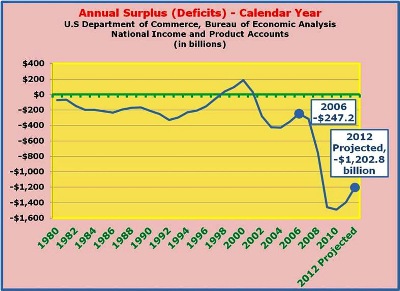
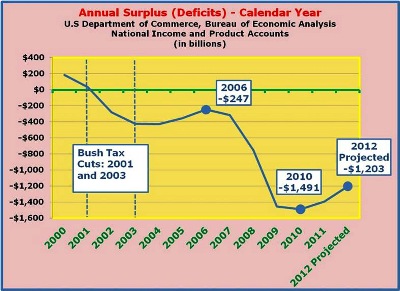
These extremely large federal deficits over the past four years has initiated increased fears of sovereign risk, that is to say, the fear of the Federal Government of the United States defaulting on the national debt. This phenomenon of the materialization of sovereign risk by nations such as Greece is considered by some to be a foreshadowing of what may happen to the United States of America if expenditure discipline does not return to the Federal Government’s budgetary process.
Of equal concern are two other problems. One is what is being referred to as the economy falling off a “Fiscal Cliff”. It would be a result of a combination of substantial tax rate increases proposed by President Obama and significant government spending cuts proposed by the Republican majority in the House of Representatives. Both the tax rate increases and the government expenditure reductions would reduce aggregate demand and most likely continue the economic malaise in which the U.S. economy is currently wallowing. What happened to the teachings of John Maynard Keynes?
United States fiscal cliff
http://en.wikipedia.org/wiki/United_States_fiscal_cliff

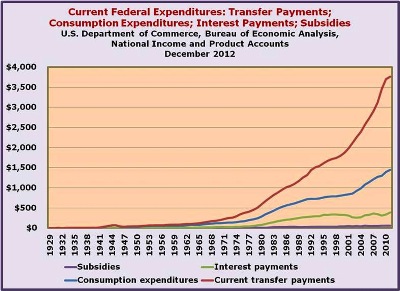
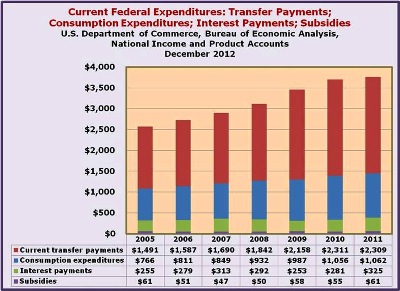
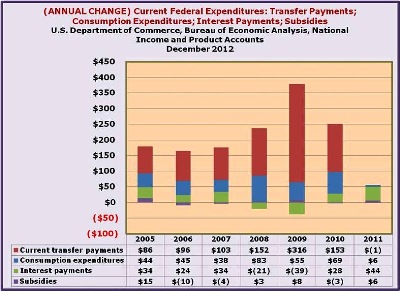
The second of the concerns in addition to growing fears of rising sovereign risk, is the nature of the tax rate increases. Placing all of the tax rate increases on the so-called rich would undoubtedly reduce the national savings rate and investment in capital projects embodying the more risky technological changes. The concern here is the precluding of a faster rate of economic growth and the tax base as well.
The expenditures of government are of two types. The first category of expenditures has traditionally been called government purchases of goods and services. In theory these are often called collective consumption and investment. Such things as defense spending, public education, highway construction, and flood control are examples of this collective consumption and investment. In the national income and product accounts presented quarterly by the Bureau of Economic Analysis of the U.S. Department of Commerce, the name given to these government purchases of goods and services or collective consumption and investment, is the term Government Consumption Expenditures and Gross Investment. All three of these expressions have the same meaning.
A second type of expenditure by government is referred to as transfer payments. These are receipts usually of households and usually from government but occasionally from business and other households. There are also transfer payments to state and local governments from the federal government. The distinguishing characteristic that makes them transfer payments and not ‘earned’ income, is that they do not result from the current offering of a productive resource such as capital or labor in the transformation process of production of gods and services. They may result from the delayed compensation to a productive resource in a previous, but not in the current period. In the majority of cases, they were NEVER earned as a result of the supplying of a productive resource to the production process.

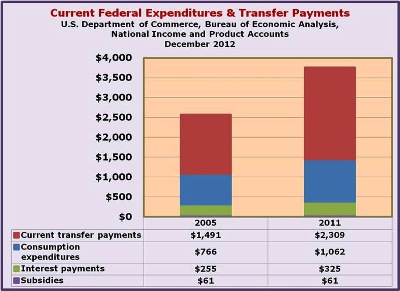
The transfer payment, Social Security benefits are received after retirement and result from being taxed in qualified employment in previous periods, but not from current employment. At the risk of redundancy, we once again emphasize that the bulk of the transfer payments are to households and are not because they are supplying productive resources in the transformation process of production, but simply unearned additions to the household disposable income.
The transfer payments can be in cash or in kind. Examples of cash transfers are so security benefits and family income allowances. An example of an in-kind transfer payment would be Medicaid benefits.
The pattern of federal government expenditures is significantly different than those of the state and local governments also referred to as municipalities. The large majority of federal government expenditures are transfer payments that are often nearly twice as large as are the federal government’s expenditures on goods and services or collective consumption and investment.
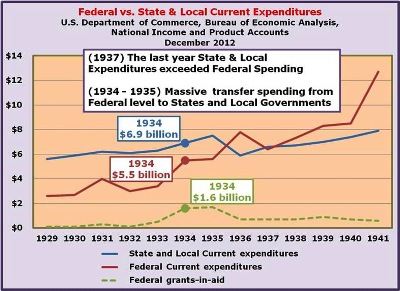
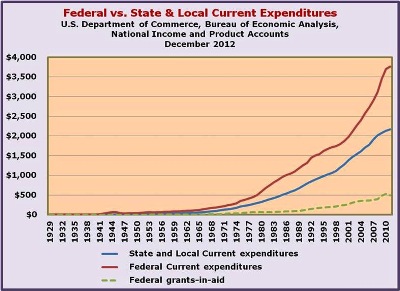
In normal years, the pattern is reversed for state and local governments, with collective consumption and investment (purchases goods and services) being the large majority of total municipal expenditures, the balance being in transfer payments. It should be pointed out, that many of the state government transfer payments such as Medicaid, are required of the state and local governments by federal government mandates even though there are only partially funded or in some cases completely unfunded by the federal government.
Another consideration is that of the two levels of government the federal level and governments below the federal level such as states, cities, counties, etc, the geographical tax base is significantly different. It is much smaller for the state and local governments than it is for the federal government. As a result, the bulk of state and local government (municipal government) debt is held externally or outside of the geographical area of the state or local government in question. They have very limited taxing jurisdiction beyond their own borders.
Since the federal government includes a somewhat larger geographical area than for state and local governments, a larger percentage of its outstanding debt is internally held within its geographical area than for the less geographically inclusive municipal levels of government. That is why most municipal levels of government have some form of balanced budget provision in their constitutions and charters.
At least since the Second World War, most of the outstanding debt of the federal government of the United States had been held by households, businesses, and federal agencies within the United States. Since 1980, however, there has been a growing tendency for an increasing percentage of the federal debt being held externally by those outside of the United States such as for example, mainland China.
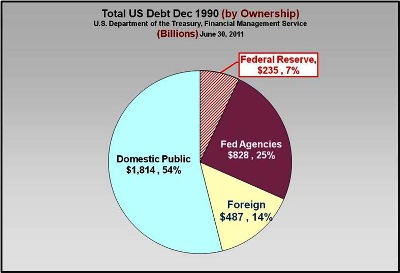
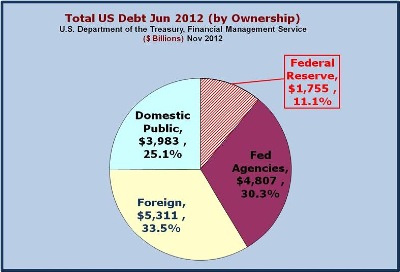
Now you can see why the fear of sovereign risk has been rising as the outstanding debt of the federal government of the U.S. as a percent of the nation’s GDP has been rising, primarily due to a lack of expenditure discipline over the past four years. Not having had a federal budget legislated for three years has not helped.
'Unprecedented 1,200 Days' Since Senate Democrats Passed a Budget
(August 10, 2012)
http://budget.house.gov/news/documentsingle.aspx?DocumentID=306183
If a government’s debt is internally held, then the debt service (payment of interest and paying off maturing debt if not refinanced) by the government simply transfers purchasing power from those taxed to those receiving interest on that debt or its repayment. If the debt service is on internally held debt, then both the taxpayer and the recipient of the debt service payments are within the geographical area of the government in question.
Externally held that is much more serious since then service by the government is undertaken by taxing people within the geographical area of that government and transferring the purchasing power to recipients of the debt service payments outside of that area.
Traditionally, that has meant that state and local government debt is a much more serious issue than for the federal government. Unfortunately, the picture has been changing for the federal government as a significant percentage of the federal debt is now being held by those outside of the U.S.
Much of this tendency is due to our persistently large trade deficits. Those trade deficits in turn are often die to the pegging of exchange rates in a favorable manner for strengthening their own economies by causing a significant trade surplus for them with the U.S. which is the same as a trade deficit of the U.S. This is clearly the case with mainland China. Theory tells us that trade deficits depress an economy as its depressing imports exceed its stimulating exports. In the terminology of Keynesian economics, exports raise aggregate demand while imports lower aggregate demand. Thus trade deficits depress a nation‘s aggregate demand.
This relative increase in the externally held portion of the outstanding federal debt of the U.S. Government is the major reason for the rise of the level of sovereign risk of the United States government. As the ratio of outstanding debt of the U.S. Government to Gross Domestic Product rises, especially foreign held U.S. Government debt, the level of sovereign risk increases.
HAPPY NEW YEAR…2013!


